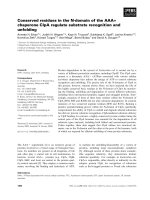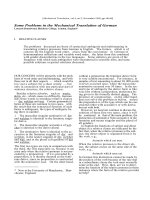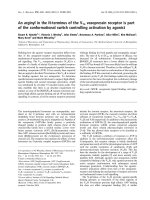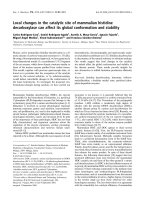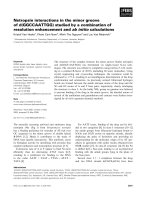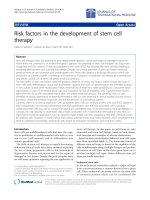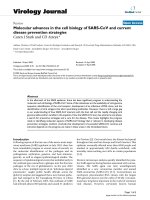Báo cáo sinh học: "Long telomeres in the polytene chromosomes of Drosophila melanogaster are associated with amplification of subtelomeric repeat sequences" doc
Bạn đang xem bản rút gọn của tài liệu. Xem và tải ngay bản đầy đủ của tài liệu tại đây (1.36 MB, 10 trang )
Original
article
Long
telomeres
in
the
polytene
chromosomes
of
Drosophila
melanogaster
are
associated
with
amplification
of
subtelomeric
repeat
sequences
ON
Danilevskaya
GE
Lapta
1
USSR
Academy
of
Sciences,
Institute
of
Molecular
Genetics,
123182
Moscow;
2
Kharkov
State
University,
Kharkov,
USSR
(Received
23
April
1990;
accepted
7
November
1990)
Summary -
The
T-32
strain
of
Drosophila
melanogaster,
which
was
originally
selected
for
heat
resistance,
is
characterized
by
having
exceptionally
long
tips
in
chromosomes X
and
2L
in
the
polytene
salivary
gland
chromosomes.
Six
sublines
differing
in
telomere
length
in
different
chromosomes
were
selected
at
an
elevated
temperature
(32°C).
The
morphological
characteristics
of
the telomeres
in
each
subline
are
stable
for
a
number
of
generations
at
23°C.
The
additional
chromatin
in
the
long
telomeres
effectively
hybridizes
with
a
DNA
sequence
designated
Dm665,
which
is
related
to
the
He-T
family
of
heterochromatin-
and
telomere-associated
sequences.
The
short
telomeres
show
weak
or
no
hybridization
with
the
Dm665
fragment.
This
result
implies
that
at
least
part
of
the
morphological
changes
in
telornere
length
in
polytene
chromosomes
results
from
different
degrees
of
amplification
of
the
telomere-associated
sequences.
D
melanogaster
/
polytene
chromosome
/
telomere
length
/
repeat
sequence
/
amplification
Résumé —
Les télomères
longs
des
chromosomes
polytènes
de
Drosophila
melanogaster
sont
associés
à
l’amplification
de
séquences
répétées
subtélomériques.
La
souche
7°-32
de
D
melanogaster,
sélectionnée
à
l’origine
pour
sa
résistance
à
la
chaleur,
se
caractérise
par
des
extrémités
exce
P
tionnellement
allongées
de
ses
chromosomes
X
et
2L
(chromosomes
polytènes
des
glandes
salivaires).
Six
sous-lignées,
différant
par
la
longueur
des
télomères de
différents
chromosomes,
ont
été
sélectionnées
à
température
élevée
(32°
C).
Dans
chacune
des
sous-lignées,
les
caractéristiques
des
télomères
demeurent
stables
pendant
plusieurs
générations
à
23° C.
La
chromatine
additionnelle
des
longs
télomères
s’hybride
avec
une
séquence
d’ADN
(Dm
665)
apparentée
à
la
famille
He-
T
de
séquences
associées
à
l’hétérochromatine
et
aux
lélomères.
Les
télomères
courts
préserctent
une
hybridation
faible
ou
nulle
avec
le
fragment
Dm
665.
Ces
résultats
indiquent
qu’au
moins
une
partie
des
modifications
morphologiques
de
la
longueur
des
télomères
des
chromosomes
polytènes
peut
être
attribuée à
des
variations
du
degré
d’amplification
des
séquences
associées
aux
télomères.
D
melanogaster
/ chromosome
polytène
/ longueur
de
télomère
/ séquence
répétée
/ amplification
*
Correspondence
and
reprints
INTRODUCTION
Polytene
chromosomes
from
different
wildtype
strains
of
Drosophila
melanogaster
can
differ
by
the
amount
of
chromatin
in
the
telomeres
of
different
chromosomes.
Morphologically,
some
telomeres
appear
long
and
others
short
(Roberts,
1979).
The
additional
chromatin
in
the
long
telomeres
has
no
well
defined
band
structure
but
can
vary
in
size
and
general
morphology.
The
morphological
peculiarities
of
telomeres
can
persist
for
a
number
of
generations
and
serve
as
cytological
markers
in
certain
wildtype
stocks
(Lapta
and
Shakhbazov,
1986).
It
seemed
possible
that
the
long
and
short
telomeres
might
result
from
differential
amplification
of
one
or
more
subtelomeric
repeat
sequences
found
in
the
Drosophila
genorne.
This
hypothesis
was
examined
using
the
cloned
DNA
fragment
Dm665
and
the
10.5-kb
insert
of
the
phage
A 17,
which
contains
Dm665
and
2
copies
of
the
transposable
element
hoppel
(Danilevskaya
et
al,
1984).
The
Dm665
fragment
is
an
AT-rich
repeated
sequence
found
at
the
tips
of
chromosomes
and
in
hetero-
chromatin,
particularly
in
the
Y
chromosome.
It
is
related
to
the
He-T
family
of
heterochromatic-telomeric
sequences
(Young
et
al,
1983;
Traverse
and
Pardue,
1989).
The
Drosophila
strains
used
in
the
analysis
were
derived
from
a
stock
des-
ignated
T-32,
which
is
characterized
by
the
presence
of
additional
chromatin
in
the
telomeres
of
the
chromosome
arms X
and
2L.
T-32
originates
from
flies
col-
lected
in
N’Djamena
(Chad,
Central
Africa)
that
were
subjected
to
artificial
selec-
tion
for
increased
heat
tolerance
(Tikhomirova
and
Belyatskaya,
1980).
Flies
of
the
T-32
strain
are
exceptional
in
that
they
can
develop
from
egg
to
imago
at
32°C
without
losing
their
fertility.
Furthermore,
when
T-32
is
reared
at
high
tempera-
tures,
sublines
can
be
obtained
that
have
additional
chromatin
at
the
tips
of
one
or
more
chromosome
arms
in
the
salivary
gland
chromosomes.
The
mechanism
of
ori-
gin
of
these
telomeric
variants
is
uncertain,
but
the
telomere
morphology
is
stable
in
successive
generations
when
the
sublines
are
reared
at
23°C.
In
this
way
we
ob-
tained
6
sublines
of
T-32
that
exhibited
different
telomere
morphologies,
including
sublines
that
differ
from
one
another
by
long
and
short
telomere
variants
of
the
same
chromosome
arm.
We
have
found
that
the
additional
chromatin
of
the
long
telomeres
intensively
hybridizes
with
labeled
Dm665
sequences.
The
short
telomeres
show
a
much
weaker
hybridization
(or
none
at
all)
with
the
probe
sequences.
We
conclude
that
the
morphological
changes
in
the
telomeres
of
polytene
chromosomes
are
caused
by
different
degrees
of
amplification
of
at
least
Dm665
and
perhaps
other
telomere-
associated
sequences.
MATERIALS
AND
METHODS
Drosophila
stocks
The
heat-resistant
strain
T-32,
kindly
provided
by
MM
Tikhomirova,
served
as
starting
material.
One
generation
of
flies
was
reared
at
32°C,
and
a
number
of
sublines
were
created
by
mating
2
males
and
2
females
chosen
at
random.
The
sublines
were
maintained
at
23°C.
The
telomere
morphology
of
the
sublines
was
examined
in
polytene
chromosome
squashes
prepared
by
standard
procedure
(Atherton
and
Gall,
1972)
with
minor
modifications.
In
situ
hybridization
Polytene
chromosomes
of
salivary
glands
of
D7
-osophila
larvae
were
prepared
ac-
cording
to
Gall
and Pardue
(1971).
The
DNA
probes
were
labeled
with
tritiated
thymidine
by
nick
translation.
The
2.4-kb
Dm665
fragment
was
obtained
by
sub-
cloning
the
Dm665
HindIII
fragment
from
plasmid
p665
into
pBR322
(Danilevskaya
et
al,
1984).
A
larger
fragment
homologous
to
Dm665
was
obtained
from
a
10.5-kb
insert
in
bacteriophage
A 17.
This
fragment
includes
not
only
sequences
homolo-
gous
to
Dm665
but
also
2
copies
of
a
novel
transposable
element
designated
hoppel
(Kurenova,
personal
communication).
Hybridization
sites
of
the
probes
were
deter-
mined
in
5-10
individuals
in
each
subline.
Although
the
figures
in
this
paper
were
prepared
from
material
hybridized
with
A17
for
the
sake
of
signal
intensity,
the
same
results
were
obtained
when
the
material
was
hybridized
with
Dm665.
Hence
we
at-
tribute
the
pattern
of
hybridization
signals
obtained
with
A17
as
coming
at
least
from
the
Dm665
sequences
it
contains
and
perhaps
also
from
the
hoppel
elements.
RESULTS
Selection
of
T-32
sublines
with
different
telomere
morphology
The
polytene
chromosomes
of
strain
T-32
have
additional
blocks
of
chromatin
in
the telomeres
of
the
chromosome
arms
I
and
2L.
When
T-32
is
reared
at
high
temperatures
(32°C),
sublines
can
be
isolated
that
differ
in
telomere
morphology,
and
these
variants
are
stably
maintained
at
23°C.
The
generation
of
these
stable
sublines
allowed
us
to
study
sublines
with
additional
telomeric
chromatin
in
different
chromosomes,
and
we
were
able
to
obtain
different
combinations
of
chromosomes
with
long
and
short
telomeres
in
the
same
genetic
background.
The
morphology
of
the
long
and
short
telomeres
found
at
the
tips
of
the
X,
2L,
and
3R
is
illustrated
in
figure
1.
Six
sublines
differing
in
telomere
morphology
with
particular
combinations
of
long,
intermediate,
and
short
telomeres
are
diagrammed
in
figure
2
(lines
A-F).
The
telomeres
in
some
lines
are
not
as
long
as
the
long
telomeres,
and
not
as
short
as
the
short
telomeres,
and
we
call
them
&dquo;intermediate&dquo;
only
to
indicate
this
ambiguity.
Flies
with
short
telomeres
in
all
the
chromosomes
(exemplified
by
subline
E)
occurred
with
the
lowest
frequency.
Such
sublines
are
somewhat
unstable
and
quickly
acquire
long
telomeres
in
some
chromosomes,
most
often
in
the
right
arm
of
chromosome
3
(eg,
subline
F).
In
situ
hybridization
of
larval
salivary
gland
polytene
chromosomes
from
different
T-32
sublines
with
telomere-associated
probes
Polytene
chromosomes
from
the
6
sublines
with
morphologically
different
telomeres
were
subjected
to
in
situ
hybridization
with
2
probes
containing
sequences
homol-
ogous
to
the
subtelomeric
repeat
designated
Dm665
(Danilevskaya
et
al,
1984).
Parallel
hybridizations
with
Dm665
and
A17
probes
were
performed
on
salivary
glands
from
the
same
larva.
More
intense
hybridizations
of
the
same
telomeres
were
obtained
with
a
10.5-kb
sequence
cloned
in
bacteriophage
A17,
but
the
pres-
ence
of
the
mobile
element
hoppel
in
the A
phage
also
results
in
hybridization
with
the
chromocenter
and
several
sites
internal
to
the
chromosomes
arms.
A
diagrammatic
summary
of
the
labelling
data
with
the
telomere-associated
probes
is
presented
in
figur0
2.
This
composite
is
based
on
results
like
those
illustrated
in
figures
3-6,
which
show
larval
salivary
gland
polytene
chromosomes
from
sublines
A,
B,
C
and
D,
respectively,
with
and
without
hybridization.
Figures
3
(subline
A)
and
5
(subline
C)
show
the
telomeric
regions
only,
while
figures
4
(subline
B)
and
6
(subline
D)
show
the
entire
euchromatic
complement.
The
arrows
indicate
the
additional
chromatin found
in
the
long
telomeres.
In
all
the
sublines
the
long
X
and
2L
telomeres
carrying
additional
chromatin
can
be
seen
to
hybridize
effectively
with
the
telomere-associated
probes.
The
appearance
of
additional
chromatin
in
the
3R
telomere
(sublines
D
and
F)
leads
to
enhanced
hybridization
of
this
chromosome
tip
(figs
1,
6).
Note
that
these
sublines
also
exhibit
some
hybridization
with
the
3L
telomere,
which
is
unlabeled
in
the
other
sublines.
All
the
short-telomere
variants
of
the
X
chromosome
also
hybridize
with
a17,
but
less
intensely
than X
chromosomes
with
the
long
telomeres.
The
short
2L
telomeres
in
sublines
B,
E
and
F
do
not
hybridize
to
a
detectable
level
with
A17
(fig
4),
nor
do
the
short
3L
telomeres
in
sublines
A,
B,
C
and
E
(figs
4,
5).
The
pattern
of
hybridization
is
especially
clear
in
heterozygotes
produced
by
crossing
the
sublines,
in
which
only
one
of
the
homologues
has
additional
chromatin
in
the
2L
telemore.
Figure
7
shows
the
intensive
labelling
of
the
long
2L
homologue
as
compared
with
the
hardly
noticeable
label
in
the
homologue
with
the
short
telomere.
This
result
demonstrates
that
the
short
telomeres
do
contain
a
small
number
of
copies
of
telomere-associated
sequences
homologous
to
a17.
These
are
revealed
by
an
appropriately
labeled
probe,
even
though
they
are
not
associated
with
morphologically
visible
additional
chromatin.
Overall,
our
results
imply
that
the
labeling
intensity
of
telomeres
when
hybridized
with
the
telomere-associated
probe
Dm665
or
A1
directly
correlates
with
the
presence
of
additional
chromatin.
DISCUSSION
Morphological
differences
among
the
telomeric
regions
of
polytene
chromosomes
in
different
Drosophila
strains
have
been
known
for
some
time
(Roberts,
1979).
The
long
and
short
telomeres
differ
by
additional
chromatin
that
may
occur
in
different
chromosomes.
However,
most
of
the
differences
have
been
observed
in
strains
of
very
diverse
genetic
backgrounds.
In
our
study
the
sublines
differing
in
telomere
length
all
derive
from T-32
and
so
have
a
common
genetic
background.
The
obvious
next
step
in
the
analysis
of
morphological
variation
in
telomeres
is
to
determine
what
DNA
sequences
comprise
the
additional
chromatin.
The
molec-
ular
structure
of
telomeres
is
under
intensive
investigation
in
a
number
of
sys-
tems,
and
a
general
pattern
seems
to
have
emerged
(Blackburn
and
Szostak,
1984).
The
ends
of
chromosomal
DYA
consist
of
simple,
tandemly
satellite-like
sequences
that
are
species
specific.
Adjoining
these
are
telomere-associated
repeats
of
varying
length,
often
organized
in
tandem
arrays.
The
sequences
at
the
chromosome
tips
in
Droso
P
hila
have
not
been
established,
but
telomere-associated
fragments
have
been
cloned
in
several
laboratories
(Rubin,
1978;
Young
et
al,
1983;
Renkawitz-Pohl
and
Bialojan,
1984).
They
belong
to
the
He-T
family
of
sequences
found
in
the
telomeric
and
heterochromatic
regions
of
the
genome
(Young
et
al,
1983;
Traverse
and
Pardue,
1989;
Biessmann
et
al
n
1990;
Levis,
personal
communication).
The
fragment
Dm665
(Danilevskaya
et
al,
1984),
which
is
a
member
of
the
He-T
family
of
repetitive
sequences,
is
located
in
the
Y
chromosome
and
shares
homology
with
sequences
located
in
subtelomeric
regions
(Danilevskaya
et
al,
1984;
and
unpub-
observations).
The
telomere-associated
sequences
also
frequently
contain
mo-
bile
elements
of
various
kinds
(Danilevskaya,
unpublished
observations).
One
of
these
mobile
elements,
designated
hoppel,
is
frequently
associated
with
the
He-T
family
and
is
present
in
the
A1
clone
(Kurenova,
personal
communication).
The
Drosophila
melanogaster
strain
T-32,
originally
selected
for
increased
heat
tolerance,
has
provided
an
excellent
experimental
model
for
obtaining
sublines
with
altered
telomere
morphology.
Rearing
T-32
at
32°C
results
in
a
high
frequency
of
alterations
in
telomere
morphology,
and
sublines
differing
in
telomere
morphology
can
be
stably
maintained at
23° C.
Hybridization
of
labeled
telomere-associated
probes
with
salivary
gland
polytene
chromosomes
from
different
sublines
of
T-32
demonstrated
that
sequences
homolo-
gous
to
Dm665
are
amplified
in
the
long
telomeres.
The
short
telomeres
show
a
far
less
intense
hybridization,
and
in
some
cases
no
detectable
hybridization.
Hence,
the
morphologically
visible
additional
chromatin
in
the
long
telomeres
results
from
the
amplification
of
at
least
Dm665
and
perhaps
other
telomere-associated
DNA
sequences.
Roberts
(1979)
proposed
that
the
long
and
short
telomeres
result
from
a
heritable
difference
in
the
location
of
a
transition
zone
between
polytene
and
non-
polytene
chromatin.
Our
results
suggest
that
the
long
telomeres
may
result
from
the
amplification
of
telomere-associated
sequences.
This
may
occur
in
the
germline
and
merely
be
observed
in
the
polytene
chromosomes,
or
the
amplification
may
occur
specifically
in
the
salivary
gland
and
perhaps
other
polytene
chromosomes.
A
critical
test
will
require
direct
in
situ
comparison
of
salivary
gland
chromosomes
and
metaphase
chromosomes
from
other
tissues,
in
order
to
allow
an
estimation
of
the
number
of
copies
of
Dm665
that
occur
in
the
tips
of
metaphase
chromosomes
in
diploid
tissues.
The
effect
of
temperature
on
the
morphology
and
pattern
of
hybridization
of
telomeres
in
sublines
selected
from
T-32
is
highly
unusual.
The
result
suggests
that
elevated
temperature
may
stimulate
deletion,
amplification,
or
rearrangement
of
the
telomere-associated
gene
family.
Except
for
the
effect
of
elevated
temperature,
the
processes
involved
may
be
entirely
conventional,
for
example,
unequal
crossing
over
or
gene
conversion.
However,
the
He-T
gene
family
may
be
subject
to
unprecedented
processes.
For
example,
Traverse
and
Pardue
(1988)
and Biessmann
et
al
(1990)
have
described the
de
novo
addition
of
He-T
family
sequences
to
the
tips
of
broken
chromosomes.
These
additions
serve
the
role
of
telomeres
in
stabilizing
the
tips
against
the
loss
of
DNA
during
replication.
Moreover,
the
addition
of
the
He-T
sequences
to
the
ends
of
broken
chromosomes
does
not
require
sequence
homology
to
the
ends.
What
processes
are
involved
have
not
yet
been
identified,
but
it
is
possible
that
the
process
is
promoted
by
elevated
temperatures
in
the
T-32
strain.
ACKNOWLEDGMENTS
The
authors
thank
VG
Nikiforov
and
VG
Shakhbazov
for
support
and
encouragement,
MM
Tikhomirova
for
strain
T-32
stock,
ES
Belyaeva
and
BA
Leibovich
for
their
aid
and
advice,
and
DL
Hartl
for
his
help
and
encouragement.
REFERENCES
Atherton
D,
Gall
JG
(1972)
Salivary
gland
squashes
for
in
situ
nucleic
acid
hybridization
studies.
Dros
Inf
Serv
49,
131-133
Blackburn
EH,
Szostak
JW
(1984)
The
molecular
structure
of
centromeres
and
telomeres.
Ann
Rev
Biocherri
53,
163-210
Biessmann
H,
Mason
JM,
Ferry
K,
d’Hulst
M,
Valgeirsdottir
K,
Traverse
KL,
Pardue
ML
(1990)
Addition
of
telomere-associated
He-T
DNA
sequences
&dquo;heals&dquo;
broken
chromosome
ends
in
Drosophila.
Cell 61,
663-673
Danilevskaya
ON,
Kurenova
EV,
Leibovich
BA,
Shevelev
AYu,
Bass
IA,
Khesin
RB
(1984)
Telomeres
and
P-element
of
Drosophila
melanogaster
contain
sequences
that
replicate
autonomously
in
Saccharomyces
cerevisiae.
Mol
Gen
Genet
197,
342-344
Gall
JG,
Pardue
ML
(1971)
Nucleic
acid
hybridization
in
cytological
preparations.
Methods
Enzymol
21,
470-480
Lapta
GE,
Shakhbazov
VG
(1986)
Analysis
of
specificity
of ectopic
conjugation
of
telomeric
ends
of
Drosophila
melanogaster
polytene
chromosomes.
Genetika
(USSR)
22,
787-792
Renkawitz-Pohl
R,
Bialojan
S
(1984)
A
DNA
sequence
of
Drosophila
melanogaster
with
a
different
telomeric
distribution.
Chromosoma
89,
206-211
Roberts
PA
(1979)
Rapid
change
of
chromomeric
and
pairing
patterns
of
polytene
chromosome
tips
in
Drosophila
melanogaster:
migration
of
polytene-nonpolytene
transition
zone?
Genetics
92,
861-882
Rubin
GM
(1978)
Isolation
of
a
telomeric
DNA
sequence
from
Drosophila
rnelanogaster.
Cold
Spring
Harbor
Symp
Quant
Biol
42,
1041-1046
Tikhomirova
M1VI,
Belyatskaya
OYa
(1980)
Modifying
effect
of
extremal
tempera-
ture
depending
on
the
organism
adaptation
to
this
factor
on
the
action
of
radiation.
I.
Characterization
of
a
Drosophila
stock
adapted
to
high
temperature.
Genetika
(USSR)
16,
115-122
Traverse
KL,
Pardue
ML
(1988)
A
spontaneously
opened
ring
chromosme
of
Drosophila
melanogaster
has
acquired
He-T
DNA
sequences
at
both
new
telomeres.
Proc
Natl
Acad
Sci
USA
85,
8116-8120
Traverse
KL,
Pardue
ML
(1989)
Studies
of
He-T
DNA
sequences
in
the
pericentric
regions
of
Drosophila
chromosomes.
Chromosoma
97,
261-271
Young
BS,
Pession
A,
Traverse
KL,
Frech
C,
Pardue
ML
(1983)
Telomere
regions
in
Drosophila
share
complex
DNA
sequences
with
pericentric
heterochromatin.
Cell
34,
85-94
